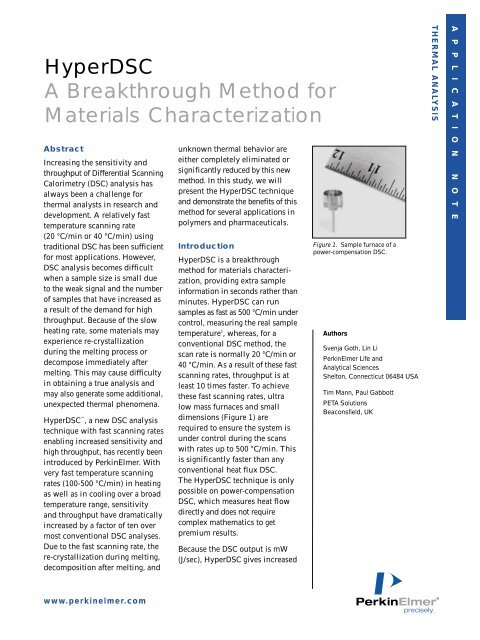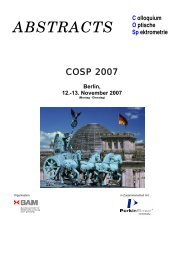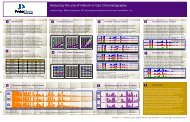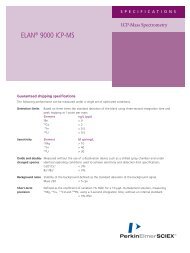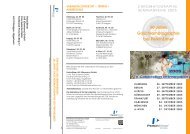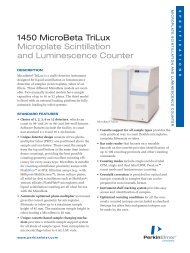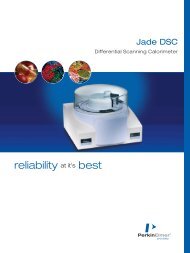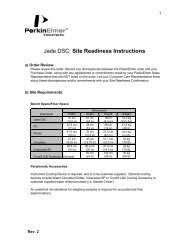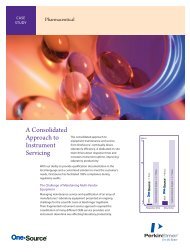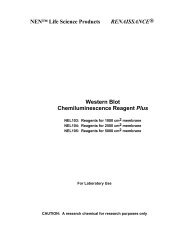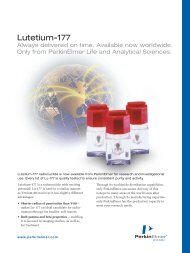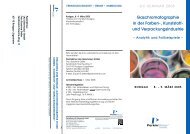HyperDSC - Perkin Elmer Instruments - PerkinElmer
HyperDSC - Perkin Elmer Instruments - PerkinElmer
HyperDSC - Perkin Elmer Instruments - PerkinElmer
You also want an ePaper? Increase the reach of your titles
YUMPU automatically turns print PDFs into web optimized ePapers that Google loves.
<strong>HyperDSC</strong><br />
A Breakthrough Method for<br />
Materials Characterization<br />
Abstract<br />
Increasing the sensitivity and<br />
throughput of Differential Scanning<br />
Calorimetry (DSC) analysis has<br />
always been a challenge for<br />
thermal analysts in research and<br />
development. A relatively fast<br />
temperature scanning rate<br />
(20 °C/min or 40 °C/min) using<br />
traditional DSC has been sufficient<br />
for most applications. However,<br />
DSC analysis becomes difficult<br />
when a sample size is small due<br />
to the weak signal and the number<br />
of samples that have increased as<br />
a result of the demand for high<br />
throughput. Because of the slow<br />
heating rate, some materials may<br />
experience re-crystallization<br />
during the melting process or<br />
decompose immediately after<br />
melting. This may cause difficulty<br />
in obtaining a true analysis and<br />
may also generate some additional,<br />
unexpected thermal phenomena.<br />
<strong>HyperDSC</strong> , a new DSC analysis<br />
technique with fast scanning rates<br />
enabling increased sensitivity and<br />
high throughput, has recently been<br />
introduced by <strong>Perkin</strong><strong>Elmer</strong>. With<br />
very fast temperature scanning<br />
rates (100-500 °C/min) in heating<br />
as well as in cooling over a broad<br />
temperature range, sensitivity<br />
and throughput have dramatically<br />
increased by a factor of ten over<br />
most conventional DSC analyses.<br />
Due to the fast scanning rate, the<br />
re-crystallization during melting,<br />
decomposition after melting, and<br />
www.perkinelmer.com<br />
unknown thermal behavior are<br />
either completely eliminated or<br />
significantly reduced by this new<br />
method. In this study, we will<br />
present the <strong>HyperDSC</strong> technique<br />
and demonstrate the benefits of this<br />
method for several applications in<br />
polymers and pharmaceuticals.<br />
Introduction<br />
<strong>HyperDSC</strong> is a breakthrough<br />
method for materials characterization,<br />
providing extra sample<br />
information in seconds rather than<br />
minutes. <strong>HyperDSC</strong> can run<br />
samples as fast as 500 °C/min under<br />
control, measuring the real sample<br />
temperature 1 , whereas, for a<br />
conventional DSC method, the<br />
scan rate is normally 20 °C/min or<br />
40 °C/min. As a result of these fast<br />
scanning rates, throughput is at<br />
least 10 times faster. To achieve<br />
these fast scanning rates, ultra<br />
low mass furnaces and small<br />
dimensions (Figure 1) are<br />
required to ensure the system is<br />
under control during the scans<br />
with rates up to 500 °C/min. This<br />
is significantly faster than any<br />
conventional heat flux DSC.<br />
The <strong>HyperDSC</strong> technique is only<br />
possible on power-compensation<br />
DSC, which measures heat flow<br />
directly and does not require<br />
complex mathematics to get<br />
premium results.<br />
Because the DSC output is mW<br />
(J/sec), <strong>HyperDSC</strong> gives increased<br />
Figure 1. Sample furnace of a<br />
power-compensation DSC.<br />
Authors<br />
Svenja Goth, Lin Li<br />
<strong>Perkin</strong><strong>Elmer</strong> Life and<br />
Analytical Sciences<br />
Shelton, Connecticut 06484 USA<br />
Tim Mann, Paul Gabbott<br />
PETA Solutions<br />
Beaconsfield, UK<br />
THERMAL ANALYSIS<br />
A P P L I C A T I O N N O T E
sensitivity with shorter scan times<br />
and smaller sample mass. The new<br />
technique enhances DSC analysis<br />
and allows the measurement of<br />
small samples down to a few<br />
micrograms. Examples of small<br />
samples are very thin layers in<br />
multilayer films, coatings or very<br />
small amounts of materials for<br />
pharmaceutical development.<br />
Another major interest in the<br />
pharmaceutical industry is the<br />
study of polymorphism. The use<br />
of fast scanning rates can reveal the<br />
dependence of the polymorphic<br />
transitions and can allow better<br />
interpretation of related processes 2 .<br />
In the past, the simulation of realistic<br />
conditions (like injection molding)<br />
that occur in the polymer production<br />
process represented a challenge for<br />
the polymer industry. The cooling<br />
rates in polymer processing strongly<br />
influence crystallization behavior 3,4 .<br />
<strong>HyperDSC</strong> provides fast cooling<br />
capability and new insights in<br />
material processes. In addition to<br />
fast controlled cooling rates, polymer<br />
production also expressed a great<br />
need for fast heating rates 1,5 . The<br />
analysis and the linking of melting<br />
behavior prior to crystallization is<br />
often a challenge. A product which<br />
is cooled down quickly and then gets<br />
analyzed with a conventional heating<br />
rate of 10 °C/min or 20 °C/min often<br />
raises questions since the results are<br />
not reflective of the material at room<br />
temperature due to reorganization<br />
processes during the slow heating.<br />
Such reorganization can be prevented<br />
by heating at a high rate so that the<br />
relationship between crystallization<br />
and the subsequent melting becomes<br />
more transparent 1 .<br />
For all measurements it is important<br />
to ensure that the instrument is<br />
under control (program and sample<br />
temperature have the same slope)<br />
when using these fast scanning rates<br />
of <strong>HyperDSC</strong>.<br />
2<br />
Experimental<br />
Several examples of different material<br />
types will be shown in this study.<br />
A <strong>Perkin</strong><strong>Elmer</strong> Diamond DSC was<br />
used for these measurements. The<br />
DSC was calibrated for temperature<br />
and heat flow with reference materials<br />
having transitions in the range<br />
of interest. Depending on the required<br />
cooling rates, different cooling devices<br />
such as Intracooler or CryoFill<br />
(a liquid nitrogen device) were used.<br />
The CryoFill system requires Helium<br />
or a Helium/Neon mixture for sample<br />
purge which provides a temperature<br />
range from -180 °C to 585 °C with<br />
good thermal conductivity. The<br />
Intracooler configuration can also<br />
use nitrogen as purge gas.<br />
Results and discussions<br />
Figure 2 depicts how the small<br />
transients in the Diamond DSC at<br />
the start of a measurement allow<br />
data to be obtained without going<br />
Figure 2. Start transients from indium with several different scanning rates.<br />
Figure 3. Polypropylene scans with 10 °C/min (blue), 50 °C/min (red)<br />
and 150 °C/min (green).<br />
to extremely low temperatures. The<br />
power-compensation DSC technique<br />
provides a stable baseline in less<br />
than 20 seconds.<br />
With classical heating rates of<br />
10 °C/min or 20 °C/min, it is often<br />
difficult to find small transitions or<br />
to identify them as seen on the DSC<br />
curve of polypropylene generated at<br />
10 °C/min. Increasing the scan rate<br />
to 150 °C/min raises the sensitivity<br />
and allows the easy determination<br />
of the glass transition (Tg) on this<br />
polypropylene sample as shown in<br />
Figure 3. This scan took less than<br />
two minutes compared to the 20<br />
minutes that a classical DSC<br />
method requires. The results show<br />
that the onsets of the glass transitions<br />
line-up very nicely.<br />
Often, to eliminate any thermal<br />
history, material is initially heated<br />
and then cooled down under control.<br />
This is a slow process using the<br />
conventional DSC approach.
Figure 4. Polyethylene blend with different cooling rates.<br />
Figure 5. Polypropylene films.<br />
Figure 6. Carbamazepine at different scan rates.<br />
Analysis is then performed on the<br />
second heat since the sample has a<br />
known thermal history. This material<br />
is no longer in the condition in which<br />
a production process delivers it.<br />
Figure 4 shows how cooling rates<br />
can impact crystallization behavior.<br />
Cooling a polyethylene blend at<br />
10 °C/min shows two crystallization<br />
peaks. Increasing the rate to<br />
150 °C/min changes the crystallization<br />
process and curve characteristic.<br />
The next example shows the<br />
analysis of two polypropylene<br />
films. Depending on the required<br />
material properties, these films are<br />
stretched in one (regular) or two<br />
(biaxial) directions. Measuring these<br />
samples at a heating rate of 10 °C/min<br />
using traditional DSC analysis,<br />
results in very similar melting<br />
temperatures of 162 °C and 165 °C.<br />
However, if the experiment is<br />
conducted using <strong>HyperDSC</strong>, the<br />
differences are remarkable (Figure 5).<br />
The regular film shows a melting<br />
peak at 157 °C and the biaxial film<br />
at 166 °C. <strong>HyperDSC</strong> allows you to<br />
measure the real properties of the<br />
actual sample, unveiling the subtle<br />
differences which would be obscured<br />
and disappear as the sample is<br />
conditioned at low scan rates.<br />
Another polymorphic example<br />
where <strong>HyperDSC</strong> proves to be<br />
highly beneficial is Carbamazepine<br />
(Figure 6). In this particular case,<br />
two phase transitions are shown as<br />
the sample is heated. The first one<br />
is much smaller than the second<br />
and very difficult to see at slow<br />
scanning rates. The energy calculation<br />
of the small peak shows the<br />
same result independent of the<br />
heating rate. This indicates that the<br />
transition is not related to a polymorphic<br />
transition and was determined<br />
to be a dehydration process.<br />
The heat flow curve of Carbamazepine<br />
at 200 °C/min and the second derivative<br />
(Figure 7) show the transitions<br />
that are present. The second derivative<br />
at a very high scanning rate<br />
demonstrates that <strong>HyperDSC</strong> is able<br />
to pick up closely related events.<br />
An unfounded concern using<br />
<strong>HyperDSC</strong> is the loss of resolution.<br />
Figure 8 shows the run of<br />
Dotriacontane at 250 °C/min and<br />
the second derivative. It is a very<br />
valuable tool for the use of <strong>HyperDSC</strong><br />
since it clearly shows several<br />
transitions which are not resolved<br />
in the high scanning rate heat flow<br />
curve. The information can be<br />
generated in less than two minutes<br />
and helps in the selection of samples<br />
which may provide additional<br />
information at lower scan rates.<br />
www.perkinelmer.com<br />
3
Figure 7. Carbamazepine heat flow and second derivative.<br />
Figure 8. Heat flow of Dotriacontane, scanned with 250 °C/min.<br />
Conclusions<br />
<strong>HyperDSC</strong> is a very important tool<br />
for the pharmaceutical and polymer<br />
industries. It meets the urgent needs<br />
for measurements performed under<br />
process conditions. <strong>HyperDSC</strong> can<br />
also provide true information of the<br />
sample without introducing any<br />
additional interference, such as recrystallization<br />
or decomposition.<br />
<strong>HyperDSC</strong> eliminates misinterpretation<br />
of material behavior and helps<br />
to improve product quality. The fast<br />
<strong>Perkin</strong><strong>Elmer</strong> Life and<br />
Analytical Sciences<br />
710 Bridgeport Avenue<br />
Shelton, CT 06484-4794 USA<br />
Phone: (800) 762-4000 or<br />
(+1) 203-925-4602<br />
www.perkinelmer.com<br />
For a complete listing of our global offices, visit www.perkinelmer.com/lasoffices<br />
scanning rates allow users to increase<br />
sample throughput easily to 100 or<br />
more runs per day. <strong>HyperDSC</strong> can<br />
be a powerful tool for screening<br />
new materials.<br />
The increased sensitivity available<br />
with this new technique enhances<br />
the ability to identify weak transitions<br />
often missed with conventional<br />
DSC. All features of <strong>HyperDSC</strong><br />
improve researchers’ ability to study<br />
material characteristics. Accurate<br />
interpretation of results and fast<br />
scanning make <strong>HyperDSC</strong> the new<br />
and preferred tool of the pharmaceutical<br />
and polymer industries<br />
to reduce time-to-market for new<br />
products and increase manufacturing<br />
efficiency. Other markets will soon<br />
begin to discover the benefits<br />
of <strong>HyperDSC</strong>.<br />
Acknowledgments<br />
We would like to thank Thijs F. J.<br />
Pijpers, Vincent B.F. Mathot and Eric<br />
W. van der Vegte of DSM Research,<br />
The Netherlands for their valuable<br />
work in <strong>HyperDSC</strong> development.<br />
References<br />
1 Thijs F. J. Pijpers, Vincent B.F. Mathot,<br />
Bart Goderis, Rolf L. Scherrenberg,<br />
Eric W. van der Vegte; Macromoelecules<br />
2002, 35, 3601-3613.<br />
2 James L Ford, Tim Mann; <strong>HyperDSC</strong> of<br />
Polymorphic Transitions in Nifedipine,<br />
Paper at TAC2002, UK.<br />
3 Eder, G.; Janeschitz-Kriegl, H.<br />
Crystallization. In Processing of<br />
Polymers; Meijer, H. E. H., Ed.;<br />
Material Science and Technology 18;<br />
Cahn, R. W., Haasen, P., Kramer, E. J.,<br />
Vol. Eds.; VCH Verlagsgesellschaft<br />
mbH: Weinheim, Germany, 1997;<br />
Chapter 5, pp 296-344.<br />
4 Mathot, V. B. F. In Calorimetry and<br />
Thermal Analysis of Polymers; Mathot,<br />
V. B. F., Ed.; Hanser Publishers:<br />
Munich, Germany, Vienna, and<br />
New York, 1994; Chapter 9<br />
(The Crystallization and Melting<br />
Region), p 231.<br />
5 Wunderlich, B. Macromolecular<br />
Physics; Academic Press: New York,<br />
1980; Vol. 3 (Crystal Melting).<br />
©2003 <strong>Perkin</strong><strong>Elmer</strong>, Inc. All rights reserved. The <strong>Perkin</strong><strong>Elmer</strong> logo and design are registered trademarks of <strong>Perkin</strong><strong>Elmer</strong>, Inc. <strong>HyperDSC</strong> is a trademark of <strong>Perkin</strong><strong>Elmer</strong>, Inc. or its subsidiaries,<br />
in the United States and other countries. All other trademarks not owned by <strong>Perkin</strong><strong>Elmer</strong>, Inc. or its subsidiaries that are depicted herein are the property of their respective owners.<br />
<strong>Perkin</strong><strong>Elmer</strong> reserves the right to change this document at any time and disclaims liability for editorial, pictorial or typographical errors.<br />
006730A PETech-99 KG110305 Printed in USA


